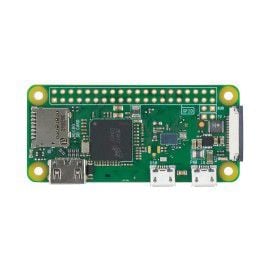Your shopping cart is empty!

Digital Signage With Raspberry Pi Zero W
- Hussien Jawhar Sathik
- 03 Jul 2023
- Tutorial
- 1662
INTRODUCTION
Digital signage refers to the use of digital displays, such as LCD screens, LED panels, or projectors, to convey information, advertising, or other forms of content in a dynamic and interactive manner. It is a modern form of visual communication that replaces traditional static signs and posters with digital screens capable of displaying multimedia content.
The key features of digital signage include:
Content Management: Digital signage systems allow users to easily create, manage, and schedule content for display. This can include text, images, videos, animations, live feeds, social media streams, and more. Content can be updated in real-time, allowing for dynamic and targeted messaging.
Remote Management: Digital signage networks can be controlled and managed remotely, enabling centralized control over multiple displays in various locations. This allows for efficient content distribution, monitoring, and updates without the need for physical intervention at each display site.
Interactivity: Some digital signage setups incorporate interactive features, such as touchscreens or motion sensors, which allow viewers to engage with the displayed content. Interactivity can enhance user experiences and enable interactive wayfinding, product exploration, or data collection.
Dynamic Content Delivery: Digital signage enables content to be scheduled and targeted to specific audiences, times, or locations. This flexibility allows for personalized messaging, targeted advertising, and real-time information updates based on factors like demographics, time of day, or current events.
Integration and Connectivity: Digital signage systems can be integrated with various data sources and external systems. This includes integration with social media platforms, weather services, news feeds, databases, and other digital systems to display relevant and up-to-date information.
Analytics and Metrics: Digital signage platforms often provide analytics and reporting capabilities. These features allow users to track audience engagement, measure the effectiveness of campaigns, and gather data for informed decision-making.
Digital signage finds applications in various industries and environments, including retail stores, corporate offices, transportation hubs, educational institutions, healthcare facilities, hospitality venues, and public spaces. It serves multiple purposes, such as advertising, wayfinding, information dissemination, brand promotion, entertainment, and enhancing customer experiences.
The benefits of digital signage include enhanced visual impact, flexibility in content delivery, real-time updates, cost savings compared to traditional print signage, improved audience engagement, and the ability to deliver targeted messaging. It offers a dynamic and versatile platform for communicating information and capturing attention in today's digital age.
HARDWARE
These are the hardware needed for this tutorial
1) 1 x Raspberry Pi Zero WH
2) 1 x HDMI mini to standard HDMI adapter/converter
3) 1 x RPi Universal PSU 5.1V 2.5A Micro B
4) 1 x High Speed HDMI Cable 1.5m
SOFTWARE
The software that we will use for this tutorial is the info-beamer. What is info-beamer?
info-beamer is a professional digital signage software platform that allows users to create, manage, and deploy content on digital signage displays. It provides a comprehensive suite of tools and features for creating dynamic and engaging visual experiences.
Key features of info-beamer include:
Content Creation: info-beamer offers a web-based interface and a powerful SDK for creating and designing multimedia content. Users can create slideshows, videos, HTML-based content, and interactive applications using a wide range of supported formats and technologies.
Content Management: The platform allows users to manage and organize their content libraries, making it easy to upload, schedule, and update content on their digital signage displays. Content can be organized into playlists and scheduled to be displayed at specific times or in specific sequences.
Customizability: info-beamer provides extensive customization options, allowing users to tailor the look and feel of their digital signage content. Users can apply custom CSS styles, add overlays, and use advanced scripting to create interactive and personalized experiences.
Device Management: The platform enables users to manage and monitor their digital signage devices remotely. Users can configure settings, update software, monitor device status, and troubleshoot issues, all from a centralized dashboard.
Interactivity: info-beamer supports interactivity in digital signage displays. Users can create touch-enabled applications or use external input devices, such as motion sensors or buttons, to trigger content changes or engage users with interactive experiences.
Real-time Data Integration: The platform allows users to integrate real-time data from various sources into their digital signage content. This can include weather information, social media feeds, news updates, or data from external APIs, enabling dynamic and up-to-date content displays.
Scalability and Multi-screen Support: info-beamer can handle deployments of any size, from single displays to large-scale networks of hundreds or even thousands of screens. The platform provides centralized management and synchronization capabilities, making it easy to manage multiple screens and ensure consistent content across the network.
Security and Reliability: info-beamer prioritizes security and reliability, with features like automatic device updates, secure communication protocols, and encryption of sensitive data. The platform also offers robust monitoring and alerting features to detect and address any issues that may arise.
info-beamer is widely used in various industries, including retail, hospitality, corporate environments, education, and transportation. Its flexibility, advanced features, and user-friendly interface make it a popular choice for organizations seeking to create impactful and dynamic digital signage displays.
Now let's get started
The video will shows the step-by-step guide to create a digital signage.
Hardware Components
Raspberry Pi Zero W
RM72.50 RM82.50
High Speed HDMI Cable
RM7.90
Raspberry Pi Universal Power Supply 5.1V 2.5A m...
Discontinued
Official RPi mini HDMI adapter
Discontinued
 International
International Singapore
Singapore Malaysia
Malaysia Thailand
Thailand Vietnam
Vietnam



